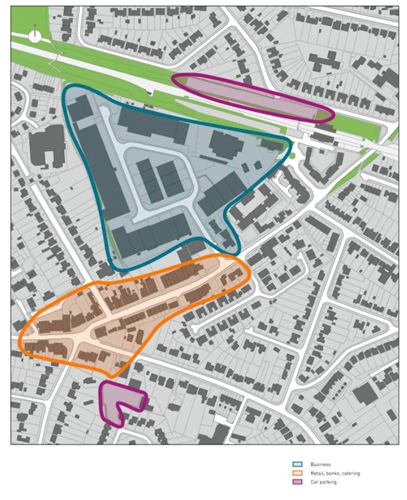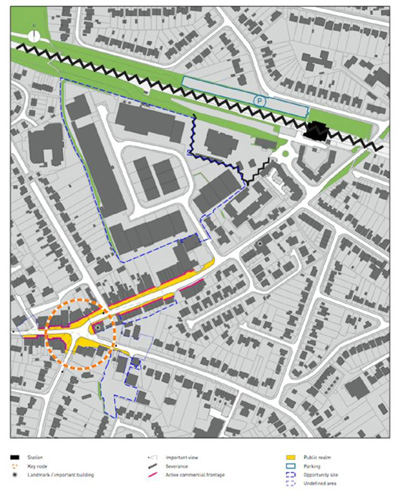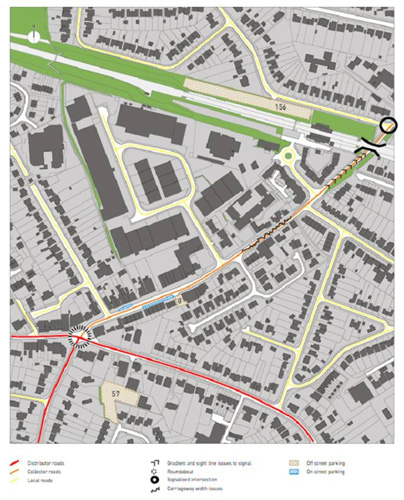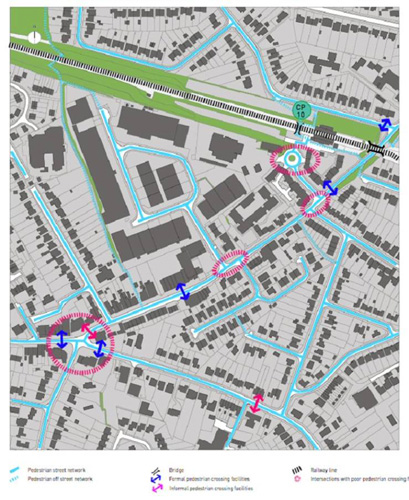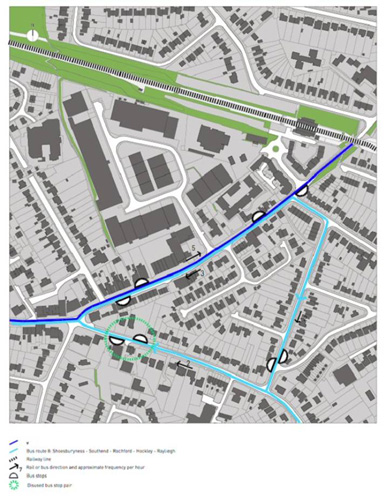Hockley Area Action Plan - Issues and Options
2. THE ISSUES
(8) 2.1 INTRODUCTION
2.1.1 In preparing this Area Action Plan consultation was undertaken with the public via the Council's website and through a Placecheck Initiative where members of the Citizens Panel were invited to particpate in a workshop event to explore issues and opportunities for the Town Centre. The feedback from these exercises has helped to shape and inform the vision and strategy to the future planning, development and regeneration of the town centre. The main points raised are presented in the sections below.
(29) 2.2 WHAT YOU TOLD US
Interactive web-based consultation
2.2.1 The web based consultation highlighted a number of key points which are summarised below:
-
Parking regulations are disregarded (they should be more clearly marked) and there should be more free parking (suggested site was on the Plumberow Avenue side of the Railway Station)
-
There is litter on the streets and many aspects of the town environment are in a poor state of repair including bus shelters and seats, open space near the railway bridge, the pavements, the shop car parks and shop fronts,
-
There is not a wide range of shops: too many charity shops / take away shops / closed down shops, not enough family restaurants, cafes and clothes stores
-
There could be improvement of the station forecourt
-
A youth meeting place is needed and it was suggested that Spa Pump rooms could be used for a community use
-
CCTV cameras are needed
-
There is a need to improve traffic issues in Hockley - Traffic congestion at Spa Road roundabout and the junction of Spa Road, Station Road and Station Approach - and there should be more cycling facilities
-
Development should take place through infilling existing sites / replacing houses with flats rather than encroaching into the greenspace. In addition if development were to take place, infrastructure should match the housing development.
-
Development should be environmentally friendly
Placecheck Initiative
2.2.2 The Placecheck events were held to help inform ideas and options for future change and improvement in the town centres of Rochford and Hockley, ensuring that the views and opinions of local residents help generate these options. Placecheck is a method of assessing the qualities of a place, showing what improvements are needed, and focussing people on working together to achieve them. Placecheck asks questions about the processes of change and the potential for improving the area physically (more details of the place check process can be found in appendix B). The findings are summarised in the table below.
Table 1: Summary of Placecheck consultation responses
|
Questions |
Comments |
|
What do you like about Hockley? |
- Has a village feel - is known locally as 'the village' - Feeling of community - people know each other - Flowers in the summer - Christmas lights and ceremony - People stay once they have moved in |
|
What do you dislike about Hockley? |
- Rubbish - Traffic - Lack of good shopping - Lack of restaurants - Too many take-away restaurants and charity shops - Poor quality public space at junction of Spa Road and Southend road - Spa building empty - No heart of the village - Inadequate maintenance of buildings - civic pride |
|
What can be changed / improved? |
- A new heart is needed for the town centre - is currently the main road junction - Join the RC Church garden to the High Street - a new green link - A new square on Eldon Way to rear of Somerfield - Facilities and activities for the youth - youth centre / playground - Cheaper and more frequent public transport - More bike racks - Better community facilities - multi-functional buildings - Better security - CCTV - New leisure and youth uses in Eldon Way, with better links to the town centre - Possible redirection of traffic through one-way system - Toll road! - Proper planted areas around station bridge and steps - Traffic management between station access and road opposite - Car parking to supermarkets and service access |
(20) 2.3 URBAN DESIGN ANALYSIS
2.3.1 To properly understand how both town centres work we have undertaken a survey and analysis of both areas in terms of physical development, scale, character, legibility and permeability. This has been based upon the seven objectives of urban design as established through the Government guidance document; 'By Design, Urban Design in the Planning System: Towards Better Practice'. The seven objectives of urban design are:
-
Character: A place with its own identity;
-
-
To promote character in townscape and landscape by responding to and reinforcing locally distinctive patterns of development, landscape and culture
-
-
Continuity and Enclosure: A place where public and private spaces are clearly distinguished;
-
-
To promote the continuity of street frontages and the enclosure of space by development which clearly defines private and public areas
-
-
Quality of the Public realm: A place with attractive and successful outdoor spaces;
-
-
To promote public spaces and routes that are attractrive, safe, uncluttered and work effectively for all in society, including disabled and elderly people
-
-
Ease of movement: A place that is easy to get to and move through;
-
-
To promote accessibility and local permeability by making places that connect with each other and are easy to move through, putting people before traffic and integrating land uses and transport
-
-
Legibility: A place that has a clear image and is easy to understand;
-
-
To promote legibility through development that provides recognisable routes, intersections and landmarks to help people find their way around
-
-
Adaptability: A place that can change easily;
-
-
To promote adaptability through development that can respond to changing social, technological and economic conditions
-
-
Diversity: A place with variety and choice.
-
-
To promote diversity and choice through a mix of compatible developments and uses that work together to create viable places that respond to local needs
-
2.3.2 In addition to national guidance it is important to recognise that presented within the Essex Design Guide. Originally published in the early 1970s, the Guide was updated in 1997 and again in 2005. It provides guidance for designing within the context of market towns and for lower density schemes. The latest version also provides links to the new Urban Place Supplement (UPS).
2.3.3 The UPS provides a design framework for the delivery of compact, mixed-use sustainable urban development. The guidance emphasises design quality while ensuring the improvement of infrastructure and the sustainability of existing urban places. The UPS is being adopted as a supplementary planning document by most district and borough councils in Essex. The urban design analysis undertaken as part of this baseline report is thus mindful of the advice contained within both the Essex Design Guide and UPS.
2.3.4 This analysis is summarised in the table below, with more detail provided in subsequent plans, images and associated text.
Table 2: Summary urban design assessment of Hockley town centre
|
Urban Design Objective |
Analysis |
|
Character |
Hockley town centre is linear, running along Spa Road to the junction with Southend / Main Roads. These are primary traffic routes and have relatively high volumes of traffic along them. The main historic focus of the centre is at the junction of these roads. This is however traffic dominated, buildings are a mix of scales and typologies and it suffers from a lack of coordinated public realm. |
|
Continuity and Enclosure |
Development in the town centre is a mix of scales: it is incoherent and uncoordinated. There are many single storey retail units along Spa Road and an ill-defined building line, which undermines the quality of public space. |
|
Quality of the Public Realm |
A mass of street furniture and other clutter diminshes the quality and attractiveness of space. This is a particular problem at the junction of Spa Road and Main Road, but also continues along Spa Road where guardrails, on-street parking and some level changes between the road and pavement reduce the enjoyment of the town centre. |
|
Ease of Movement |
Given the size of the town centre, it is very walkable. However, better definition of the public realm and enhanced pedestrian crossing facilities may assist local movement. The employment area to the north of the town centre is accessed via one main route which is used by both pedestrians and vehicles. Improving the quality of this and providing additional routes might encourage greater movement and enhanced connectivity. |
|
Legibility |
Hockley town centre is poorly defined and there are few clues as to the historic role and development of the town. Gateway features are lacking and the centre rapidly blends into the surrounding residential areas. |
|
Adaptability |
The town centre has some good examples of historic buildings, although these are interspersed with more recent purpose built development which may not lend itself to reuse. Leisure uses are beginning to locate in the employment area, although redevelopment is likely to be required to accommodate an enhanced town centre retail offer / community facilities. |
|
Diversity |
The mix of uses within the town centre is relatively limited. The retail offer is lacking, although the viability of this is supported by the presence of the neighbouring employment area. The town centre has a cluster of community uses, although this could be better integrated with the centre. |
(28) 2.4 LAND USES
2.4.1 The core retail area in Hockley is along Spa Road and the junction with Main Road and Southend Road. Although primarily retail in nature, this core area also includes a number of commercial activities and community uses, including a cluster of such buildings on Main Road / Southend Road comprising a library, doctors and dental surgery. These are served by a small car park.
2.4.2 The largest retail units are found to the north of Spa Road, although the largest recognisable high street chain store is Somerfield. The retail offer mainly comprises convenience goods. Some of the units here have residential or office space above, although these two-three storey buildings are interspersed with a number of single storey units. Along the southern side of Spa Road, retail units are accommodated on a relatively narrow strip of land and all are single storey. Opportunities may exist to explore how larger retail units might be created and how more efficient use of the land can be encouraged.
2.4.3 The other main land use within the study area is the employment / industrial area to the north of Spa Road. There have been a number of permissions for leisure uses within this area recently and thus improved links between the employment area and retail area may need to be provided. Although these employment uses might not represent the most attractive neighbouring use for the retail core, they do ensure a customer base for the town centre uses. It may thus be desirable to retain these activities in close proximity to each other, although improvements to the quality and attractiveness (in terms of the built form and environment) of these areas could help enhance the overall vitality of the town centre. The 2008 Employment Land Study stated that this employment site was strategically well placed and, if reallocated for alternative uses, provision should be made for office use within Hockley town centre.
2.4.4 The centre of Hockley blends quickly into the surrounding residential areas to the north and south of Spa Road. The majority of the units are detached and semi-detached inter war houses or bungalows. Other residential units are situated above the retail units on Spa Road
Figure 2: Broad land use plan
(20) 2.5 FORM AND STRUCTURE
2.5.1 The main focus of the town centre is the junction of Spa Road and Main / Southend Roads. This is an important node point and gateway for the town centre, where the topography of the town means there are local views to and from this point. However, it suffers from a poor quality, uncoordinated and cluttered public realm. Further, save for the refurbished pub on the junction (which is a local landmark in its own right), buildings here do little to address this important junction. They are a mix of scales and are set back at different distances from the road. The building line is relatively weak. This all results in a space that lacks a sense of place, character and distinctiveness.
2.5.2 Elsewhere, Spa Road is relatively well addressed through the presence of active shop frontages and a relatively strong building line. However, the scale of buildings here varies from one to three storeys which do not help to enclose the space: the result being that Spa Road feels wide, which may hinder pedestrian movement and thus undermine the natural retail circuit. Opportunities to improve the quality of the public realm, the scale of buildings and their relationship to the street should thus be explored.
2.5.3 Overall, the town centre is of a relatively fine grained scale. The counterpoint to this is the employment area to the north of Spa Road. This is a land hungry resource poorly related and integrated with surrounding uses and where there are some 'left over' spaces. Opportunities may exist to restructure some of this space and to better integrate it with uses on Spa Road. Opportunities may also exist to restructure the cluster of community uses along Main Road, to better link to the town centre and address exposed 'backs' around the car park.
Figure 3: Form and Structure of Hockley town centre
(30) 2.6 STREET NETWORK / MANAGEMENT
Existing Network of Streets
2.6.1 The main highway route through Hockley is along Southend Road and Main Road, linking Hockley with Rochford to the east and Rayleigh to the west. This road is relatively busy rural highway with approximately 15,000 vehicles per day counted on Main Road in September 2007 (sourced from Essex County Highway Improvements Department).
2.6.2 Spa Road heads north from the junction of Main Road and Southend Road to Ashingdon and Canewdon. The southern end of Spa Road intersects with Southend Road and Main Road, and is the primary focus of movement in the town centre. Further north, Spa Road is particularly narrow, with approximate carriageway widths in places of 5m. This is an issue given that Heavy Goods Vehicles use this route. Great Eastern Road is a collector road to the east of Spa Road, with Mount Crescent serving a similar role and providing access to the railway station car park to the north of the railway line.
2.6.3 The junction of Main Road, Southend Road and Spa Road is controlled by a roundabout. This is a busy junction in the heart of Hockleys mainstreet. To the north, the junction of Mount Crescent and Spa Road/Greensward Lane is controlled by a signalized junction. There are safety issues with this junction due to the downhill slope heading towards the signal, combined with the rail bridge blocking sightlines to the signal lanterns.
Parking
2.6.4 The Hockley railway station is served by a car park - a pay and display parking lot with 156 spaces. Observations showed that the car park was approximately 70% occupied after lunch (a Thursday in late January). Public pay and display parking is also provided behind the library where there are 57 available spaces in close proximity to Main Road / Southend Road. A small free off street parking lot is provided along Spa Road, although this only has space for eight vehicles.
2.6.5 The on street spaces were well patronised during site visits. An important point to note is that the on street parking spaces serve a critical function in supporting the local economy through enabling retail and small business premises to capture passing trade. In looking at the design of the public realm, on street parking will be a critical issue.
Figure 4: Street network plan
(15) 2.7 PEDESTRIAN AND CYCLE NETWORK
2.7.1 The street network provides the majority of Hockleys pedestrian network. The existence of culs-de-sac and the railway line limit pedestrian permeability. Off Street connections are provided in places, and ill-defined route links Spa Road to north of the railway line to Marylands Wood. Spa Road has reasonably spaced pedestrian crossing facilities along the mainstreet, although these could be improved. Traffic speeds are low and carriageway widths are narrow, assisting in informal crossings. There are a number of incidences where pedestrian crossings are poor, particularly with the two pairs of 'T' junctions of Eldon and Meadow Ways with Station Road and Station Approach. The station approach roundabout affords a decidely poor entrance to the station, although volumes are not to the level where pedestrian journeys are hampered. The roundabout of Main Road and Southend Road also warrants some improvements to the pedestrian environment. Cycle parking is provided by the station, although lacking elsewhere. The layout of streets, the volume and speed of traffic on these acts as a deterrent to cycle use.
Figure 5: Pedestrian and cycle network
(23) 2.8 PUBLIC TRANSPORT
The Rail Network
2.8.1 Hockley Station is served by the National Express line, running from London Liverpool Street Station through to Southend Victoria in Essex and is located between Rayleigh and Rochford Stations. Trains run on a twenty minute headway in peak periods and a 30 minute headway in off-peak periods from Mondays to Saturdays. A 30 minute service operates on Sundays. Hockley is approximately 46 minutes travel time from Liverpool Street station. The station is a well maintained facility that is manned during the day. The platforms are both sheltered. Seating is only provided on the eastbound platform. A pedestrian overbridge provides access between platforms.
The Bus Network
2.8.2 Only two bus routes pass through Hockley, the 7 and the 8 which run from Shoeburyness through Hockley on the way to Rayleigh. The 7 service runs from Spa Road through to Main Road. The 8 service uses Southend Road and Main Road in the westbound direction and circulates through Hockley Mainstreet along Spa Road, and returing to Southend Road via Great Eastern Road.
2.8.3 Hockley has a legible layout of bus stops through the centre with stops on the mainstreet close to the roundabout, two stops close to the station - although the design could be greatly improved - and a bus stop pair on Great Eastern Road. The final bus stop pair on Southend road adjacent to the library is not in use. This poses some issues for passengers seeking to access the mainstreet from the 8 east bound service.
Taxis
2.8.4 A taxi booth and waiting area is provided at the southern station entrance. Another rank is located on Mount Crescent to the north.
Figure 6: Public transport provision in Hockley
(36) 2.9 SUMMARY OF ISSUES
2.9.1 The key issues that face Hockley are summarised in the table below:
Table 3: Summary of issues for consideration in Hockley Town Centre
|
Theme |
Summary of the main issues |
|
Uses |
- Poor range of retail with a need for a wider and more diverse retail offer - Employment area occupies a lot of land, has a lot of exposed 'backs' and is poorly related to the rest of the town centre and therefore potential exists for the release of employment uses allowing re-use of the site to be explored |
|
Form and Structure |
- Poor quality, uncoordinated and cluttered public realm at the Junction of Spa Road and Main / Southend Road (which is the focus for the town) in which buildings do little to little to address the importance of the junction - At the Spa Road / Main Road / Southend Road Junction, the building line is weak and the space lacks a sense of place, character and distinctiveness - Buildings along Spa Road are a mix of scales and set back different distances from the road and therefore do not give Spa Road a sense of enclosure - Some buildings also represent an inefficient use of the land |
|
Street network / management |
- The northern end of Spa Road is relatively narrow (carriageway width of 5 metres in some places) which is problematic for the Heavy Goods Vehicles that use the route - The signalized junction of Mount Crescent / Spa Road / Greensward Lane is hazardous because of the downhill slope to the junction and sightlines being - On street parking spaces are well used and when considering the design of the public realm on street parking will be critical because it enables small businesses and retail to capture the passing trade - The roundabout on Station approach provides a poor entrance to the station |
|
Pedestrian / cycle network |
- There is limited permeability in Hockley because of the railway line and culs-de-sac which create barriers to movement - A number of the pedestrian crossings are poor - The pedestrian environment at the Spa Road / Main Road / Southend Road roundabout needs improvement - Cycle parking is only provided at the station and the layout of streets in addition to the volume and speed of traffic acts as a deterrent to cycling |
|
Public Transport |
- Bus routes in Hockley are legible in terms of where they are positioned, however the design of the stops and the information provided could be improved - The bus stops on Southend Road opposite the library are not in use |
|
Question: Do you agree that these are the main issues facing Hockley Town Centre? Are there any other issues that you think should be considered? |

